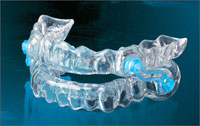
Sleep apnea is a serious, potentially life-threatening condition that is far more common than generally understood. First described in 1965, sleep apnea is a breathing disorder characterized by brief interruptions of breathing during sleep. It owes its name to a Greek word, apnea, meaning "without breath".
Central sleep apnea, which is less common, occurs when the brain fails to send the appropriate signals to the breathing muscles to initiate respirations.
Obstructive sleep apnea is far more common and occurs when air cannot flow into or out of the person's nose or mouth although efforts to breathe continue.
What is Obstructive Sleep Apnea (OSA)?
 Obstructive sleep apnea occurs when the soft tissue in a person's throat collapses and the tongue is sucked completely against the back of the throat and blocks the airway during sleep. The blood-oxygen level then drops low enough that the brain signals the body to wake up and gasp for breath.
Obstructive sleep apnea occurs when the soft tissue in a person's throat collapses and the tongue is sucked completely against the back of the throat and blocks the airway during sleep. The blood-oxygen level then drops low enough that the brain signals the body to wake up and gasp for breath.
This happens so quickly that the sleeper usually does not remember it. In a given night, the number of involuntary breathing pauses or "apneic events" may be as high as 30 or more per hour. These breathing pauses are usually accompanied by snoring between apnea episodes, although not everyone who snores has this condition. In OSA snoring, the person appears to catch his/her breath or gasp. Thus they will periodically make a choking, snorting or gasping sound when the airway reopens.
What is Snoring?
Over one third of adults snore. Snoring is a partial collapse of the soft tissue structures in the upper throat, which causes them to vibrate against each other. This produces the sound of snoring. The more collapsed the tissues, the narrower the passageway and the louder a person tends to snore.
Why is the airway narrow in snorers? The most common cause of a narrowed airway is a tongue that relaxes too much during sleep and gets sucked back into the airway with each breath taken.
In children, large tonsils and adenoids can be the cause of snoring. Pregnant women snore because of a narrowing of the airway and increased weight.
In a study conducted at Stanford University in California, one out of three chronic snorers were found to have a harmful degree of sleep apnea (where the throat becomes entirely blocked). This causes the person to stop breathing for a moment and the catch his breath. This throat blockage and lack of oxygen usually lasts between 10-30 seconds but sometimes continues for dangerously long periods of time.
The Consequences of Snoring & Sleep Apnea
Obstructive Sleep Apnea (OSA) is a serious medical condition that can have a significant impact on your quality of life, placing unnecessary strain on relationships between bed partners, family and the workplace. While loud snoring and blocked breathing are common symptoms of OSA, the following is a list of other problems that have been associated with OSA and snoring.
High Blood Pressure and Hypertension
(50% of sleep apnea patients also suffer from high blood pressure.)Heart Attack and Congestive Heart Failure
(Regular snorers have a 33% increased risk of cardiovascular disorder and patients with OSA are 4 times more likely to have a heart attack.)Stroke
(40-80% of stroke suffers also suffer from OSA)Diabetes
(48% of Type 2 diabetic patients have OSA and 80% of obese patients with diabetics have OSA)Daytime Drowsiness, Fatigue, Irritability, Lack of Concentration and Falling Asleep
(This leads to more traffic, work and other accidents.)Morning Headaches, Dry Mouth or Irritated Throat
Sudden Death
(The football star, Reggie White, died of sleep apnea.)Heartburn/Reflux/GERD
Dementia, Memory Loss, Depression
Obesity
Other Associated Problems
Insomnia, nighttime need to urinate and impotence
Treatments for Sleep Apnea and Snoring
There are three professional treatments for Sleep Apnea and Snoring.
Surgical Intervention
In severe cases surgery may be warranted to the nose, throat, tongue or jaw.CPAP - Continuous Positive Airway Pressure
In this therapy, the patient wears a mask over his/her mouth and nose that provides gentle pressure to ensure their airway stays open. This treatment may be very effective for some individuals, but may not be well tolerated by many patients. For this reason up to 50% of patients do not consistently use their CPAP machine.
Oral Appliance Therapy
The least invasive and most comfortable treatment is Oral Appliance Therapy where a custom oral appliance is made to be worn at night. It is designed to keep your air passageways clear so that you can get a restful night's sleep.
What You Can Do for Yourself?
Mild or occasional snoring and symptoms of OSA may be alleviated by life
style changes, including:
- Losing excess weight
- Getting regular exercise
- Sleeping on your side, not on your back. (Sewing a tennis ball in the back of a T-shirt can remind you not to sleep on your back.)
- Seeing a physician if you have a chronic nasal congestion or nasal obstruction.
Coordination Between Your Physician and Our Office
Your physician is best suited to formally diagnose OSA. He will chart your brainwaves, heart beat and breathing during sleep using a Polysomnogram (PSG) monitor. However, if you have the symptoms listed above, you can see us for an initial evaluation and referral to a qualified physician.












